Eldraine Check, Part 2
Last week, I started telling card-by-card design stories from Throne of Eldraine. I only made it to E, so I have a lot of stories left to tell. Let's get to it.
Faerie Guidemother
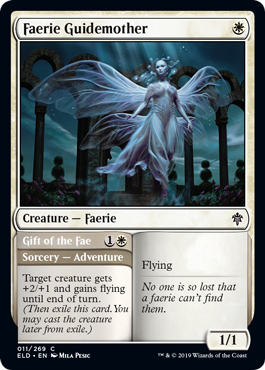
This card started in blue. Mostly because I assumed Faeries were going to be in blue and black, but the more we worked with the source material, the more we realized that this world really wanted white Faeries in addition to the blue and black ones. Here's my first stab at this design:
Faerie Godmother (uncommon)
3U
Creature — Faerie
Flash
Flying
When CARDNAME enters the battlefield, target creature you control becomes 4/4 creature until CARDNAME leaves the battlefield.
2/2
The idea behind the design was that the Faerie Godmother had the ability to transform a creature, but you never quite knew for how long. I then made a card called Stroke of Midnight in black that allowed you to sacrifice a creature to draw cards and gave you extra cards if that creature was equipped. That way, you could sacrifice whoever was wearing the Glass Slipper or the Faerie Godmother which would end her effect.
The way the card got played in playtests, sort of like a Giant Growth in blue, didn't really capture the feel that we wanted, so the card was removed from the file. Later in set design, when they were making an Adventure card in white, they decided to use the Faerie Godmother flavor there. She can temporarily change you, but in a white way.
Flaxen Intruder
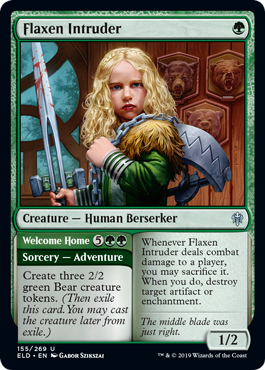
The earliest version of this card was:
Three Bears (uncommon)
5G
Sorcery
Create three 2/2 green Bear creature tokens.
That card was added to the file week one. I also think Vision Design had a mono-red Goldilocks-ish card that destroyed artifacts. In set design, the Adventure mechanic was added and the team realized that the mechanic did a good job of tying together related creatures and spells from the same story. As artifact destruction is in green as well as red, the Goldilocks card could be redone in green and Goldilocks could be connected with her Bears.
Another point about this card was that we were determined not to just retell the tropes of our source material but give them a Magic tweak. Flaxen Intruder is a great example of this. In the original fairy tale, Goldilocks is mostly just an intruder. We liked adding the shift to making her a bear hunter. That gave her a different feel than she's ever had before and helps put our stamp on the character.
Gilded Goose
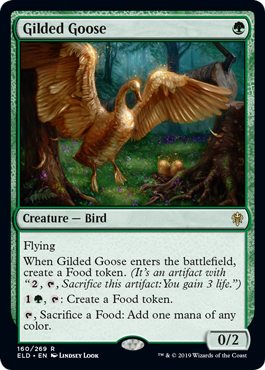
Here's the earliest version of this card:
Golden Goose (rare)
1G
Creature — Bird
Flying
G, T: Create a colorless artifact token named Gold. It has "Sacrifice this artifact: Add one mana of any color."
1/1
We don't make a lot of flying creatures in green, but we really wanted a Golden Goose, which meant we felt it had to repeatedly make Gold counters, which, in turn, meant it was either red or green, and red wasn't any better at small fliers than green, so we settled on green. (Set Design would later change it to a 0/2 to help with this issue.)
Food tokens didn't exist yet as they weren't created until set design. Once Food tokens existed, that meant the set didn't want to have Gold tokens as we tend to limit how many different tokens we make in any one set. That meant that this card had to be adapted. Obviously, it laid eggs, so those could be thought of as food. The last ability was added to allow you to convert Food into mana, which kept some of the original functionality of the card. It also helped make the "eggs" feel golden, as we equate the flavor of money in gameplay to mana.
Gingerbrute

This was one of the very first cards put into the file. It was designed by Peter Lee. Here's the original design:
Gingerbread Golem (common)
1
Artifact Creature — Cookie Construct
Haste
CARDNAME can't be blocked except by creatures with haste.
1/1
The Vision Design team adored this card and put it immediately in the set. From its creation, it was the poster child of an ongoing discussion R&D had for the duration of Throne of Eldraine's creation—what exactly was the line between things that felt right for Magic and things that felt inappropriate?
For example, early on, we also made a Puss-n-Boots card, and it was decided that animals walking around and talking like humans was a step too far for us. We could have animals with some agency (aka they could act a little smarter than normal animals), but we didn't want to cross the line of them acting like humans. Animals had to be animals and couldn't talk or dress up in human clothes. We joked that the Gingerbread Golem was the line, but we weren't quite sure which side he fell on. Artifact creatures made of various substances that come alive was very Magic. Made of gingerbread? The jury was out.
I said the card was going to stay in the file until we were told to remove it, so we kept working on it. Playtesting showed us it was a little too strong, so we added the activation to it and then there were no other changes until we handed it off to Set Design. I did make a note that the Vision Design team wanted to keep the card in the set if at all possible. I really believed it was the kind of top-down design that was going to give Throne of Eldraine its feel.
In set design, they came up with the idea of Food tokens. Once that happened, someone pointed out that the gingerbread man was food. Could they make it Food? They consulted with Eli Shiffrin (the rules manager) and discovered that yes, the rules would allow it. Food is an artifact subtype, and Gingerbrute was an artifact creature, so the team added the subtype and gave it the ability of the food tokens ("2, T, Sacrifice this: You gain 3 life."). I think the Set Design team also fell in love with the card, and as no one ever told them to take it out, it stayed. In the end, the Creative team decided that Gingerbrute was the line, but on the side that got to stay in the set.
I remember when I was watching the Throne of Eldraine slideshow that I let out a little hoot when I saw Gingerbrute had officially made it into the set. May your opponents never catch him.
Glass Casket
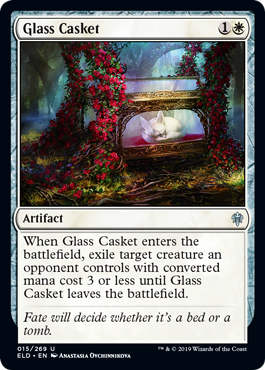
The Glass Casket is from Grimms' Fairy Tales, but it's probably not the story you think it is. Most people associate it with Snow White, but it's actually from a different story, one called "The Glass Coffin." In it, a different maiden is trapped inside it (although, she's not magically put to sleep) and is rescued not by a prince, but by a tailor's apprentice. (Fairy tales seem to really like adventuresome tailors.) Regardless, we thought it was a cool magical item that would fit well within the set. This was our first take on it:
Gilded Cage (uncommon)
5 or 1WW
Artifact
Hex — When CARDNAME enters the battlefield, exile target creature for as long as CARDNAME is on the battlefield.
I'm sure this design brings up a few questions, so let me start by answering them. First off, there are a number of tropes in fairy tales that revolve around a young lady being captured in some magical item that she then needs to be rescued from. This card started as a gilded cage but quickly changed to being a glass casket, as we felt that trope was better known, thanks to Snow White. Second, as I explained in my preview column, the Vision Design team played around with the idea of alternate mana costs. As we knew we wanted some colored artifacts, we made a bunch that allowed you to cast it cheaper if you used colored mana. Glass Casket was one of those.
Thirdly, this card is making use of an ability word we tried out called hex where things got removed while the item was on the battlefield. The idea behind hex was that we could use it to mark entrapment or transformation, and that was something that showed up a lot in fairy tales. We quickly realized that it was a little too narrow mechanically and abandoned it. Originally, the Glass Casket could capture any size creature, but playtesting showed that was a little too strong, so rather than raise the cost, we limited it to creatures of converted mana cost 3 or less. We felt that could be reflected in the flavor as the creature would have to be roughly human size or smaller to fit.
Happily Ever After
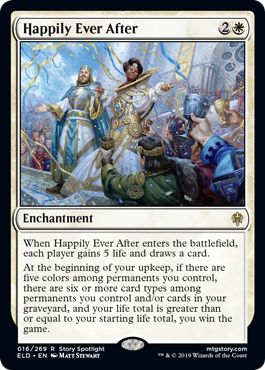
We knew we wanted to do a card called Happily Ever After. The key to the design was figuring out what it wanted to do. After some thought, we decided to make it an alternate-win-condition card, as it felt a good flavor fit with the name. Here's our first attempt at the design:
Happily Ever After (mythic rare)
2W
Enchantment
(Mark each task as you achieve it. When the quest is completed, sacrifice it for your reward.) (*) There are five colors among permanents you control.
(*) There are seven or more card types among permanents you control and/or cards in your graveyard.
(*) Your life total is higher than your starting life total. Reward — You win the game.
When this card was first designed, we were messing around with the idea of doing quests. A big part of the Camelot flavor was Knights venturing out on noble quests. The idea behind these cards was that you were given a task and if you accomplished it, you got rewarded with a big effect. The idea behind this card was that it would have a special frame so that you could mark off with a counter each time you accomplished one of the tasks.
Happily Ever After allowed us to show the end of the story, something we don't always get a chance to do on Magic cards. To match the flavor, the win condition was tied to you having done a lot of things. You have all the colors, most of the card types (we said six or more on the final card as we no longer make Tribal, but it still exists on older cards), and your life total is greater than when you started. This felt like an interesting challenge to solve, one which would force you to push your deck design into a different space than normal.
In set design, quests then got turned into a mechanic where you got a special token card with rules text on it that acted like an artifact except that it couldn't be put in your deck. You could only get it by completing a quest. The Adventure mechanic eventually came along and proved to capture the same flavor while also hitting some adventure tropes from fairy tales and quests that were dropped. Though, that wasn't the end of us making a Happily Ever After card.
The card was converted into a normal alternative-win-condition card, but that wasn't quite enough to make the card playable, so Erik Lauer, who was the final set lead on the project (Mark Gottlieb lead set design for most of the project, and Erik came in near the end when Mark was needed on another project), wanted to give the card an enters-the-battlefield effect to help make it worthwhile to put it into your deck and cast it. For flavor reasons, he liked the idea that it had one or two effects that affected all players. Life gain was an obvious choice, but Erik wanted a second ability. He wanted all players to draw a card.
The problem here is that one of white's weaknesses is its lack of card draw. It's the color with the most answers, but they're spread out, meaning white is good if it understands the threat it's facing, but has trouble if it doesn't. White's lack of flexibility is its weakness. Because of this, we don't give white good card drawing. Usually, when we do let it draw cards, it's in a very narrow situation where its deck has to be super focused. Erik came to the Council of Colors because he wanted permission to experiment pushing white card draw in this direction.
Erik's defense is that if everyone is drawing cards, white might be getting more answers, but its enemies are getting more threats. The team talked it through and decided that it was something we were happy trying out, and we gave Erik our blessing to use the ability on this card. I should note that we started low with just drawing one card as we're trying to figure out where the draw has to cap. If you draw too many cards, you overload the opponent's ability to play all their cards (and you may even force discards), which makes it more like traditional draw. I'm interested to see how this experiment plays out.
The Common Land Cycle
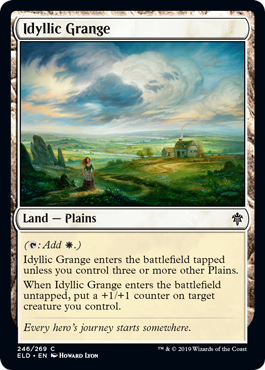
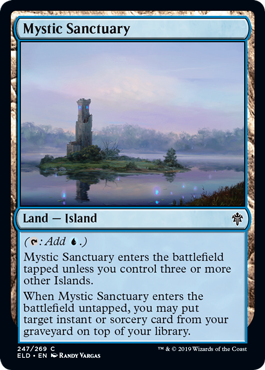
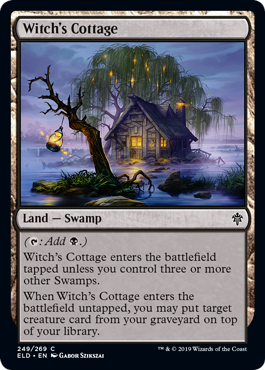
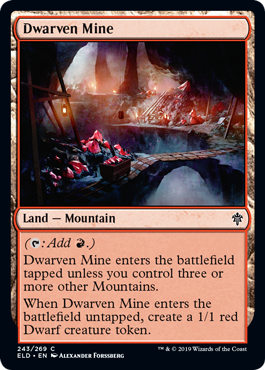
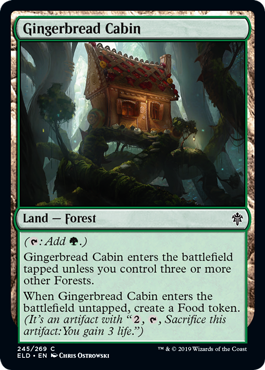
We made the castles of the courts into a rare cycle of monocolor-producing lands. We also wanted to do something at common for Limited play. This cycle also comes into play tapped unless you have the right basic land, but the common cycle requires not one but three of the land. These cards are even more playing into encouraging a monocolor deck. Each of the lands then gets an "enters the battlefield" effect that only happens if the land enters untapped. This way, you can play the lands early tapped if you need them for mana or could play them late to get their effect.
Another reason we made a cycle of common lands was there were a lot of tropes that played into locations. We were searching for where to put things like the diamond mine the seven dwarves work in or the gingerbread house that lures in Hansel and Gretel. Because we were trying to do top-down designs, we matched the "enters the battlefield" effect to the flavor of the land, so the mine creates Dwarves and the Gingerbread Cabin makes Food.
Inquisitive Puppet
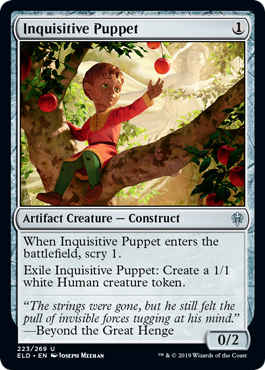
You couldn't make a fairy-tale set without Pinocchio. Here's our first attempt at the design:
Wooden Boy (uncommon)
1W or 3
Artifact
Whenever you cast a mystical spell, CARDNAME becomes a 4/4 Human creature until end of turn. (Artifacts, Enchantments, and Faeries are mystical.)
This card plays around with a different effect we tried out in vision design, something we called mystical. Using the batching technology from the historic mechanic from Dominaria, we defined mystical as three things that all had a magical element—artifacts, enchantments, and Faeries. We thought this would be a neat way to join together artifacts and enchantments. Faeries were added because I like batching with three things, and it gave an extra little oomph of flavor. In the end, the "caring about artifacts and enchantments" theme stayed, but wasn't batched, and the Faeries were no longer included.
The biggest problem with the first design is it didn't quite capture Pinocchio. Pinocchio is clearly an artifact creature that functions as an artifact creature for most of the story. Him only being Human when he briefly becomes a creature felt wrong. Also, 4/4 was a bit much for Pinocchio. The final design made him a 0/2 for one mana, so you can use him defensively or load him up with Auras, Equipment, and/or counters. Whenever you want to, you can change him into a real boy, which is a 1/1 Human creature token. He's a little less tough than his artifact version, but now he can attack without help.
Joust
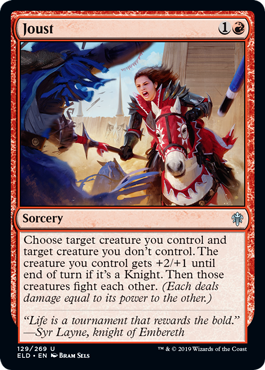
Here's another Camelot trope that we wanted to capture—jousting. Magic is a game about fighting, so jousting seemed like it would fit right in. In fact, speaking of fighting (or fight), Magic has an evergreen keyword mechanic that fits the flavor of jousting to a tee. Just these two creatures will square off against one another in a fight. That sounds a lot like jousting. There's always a common green fight spell, so we just changed the name of our Prey Upon to Joust. We thought this was a slam dunk just like Charmed Sleep, but it turns out we had one problem—the story.
You see, each of the colors was associated with a different court, and the court that liked to do all the jousting wasn't the green court but the red court. You see, the red court was where all the fun stuff happened—all the feasts and the contests. It naturally wanted to be the court of jousting.
Okay, while fight is primary in green, luckily, it's secondary in red, so we just moved it to red. It ended up being uncommon rather than common as red does less fighting, but that also allowed us to add a Knight tribal component to it (Knight tribal is in white, black, and red). Now when you fight, if your creature's a Knight, they get a little bonus.
Oathsworn Knight
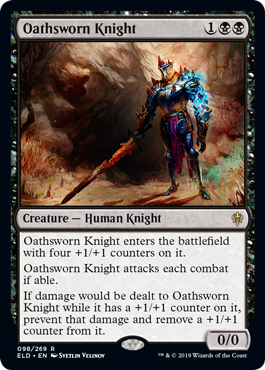
If you're doing Camelot tropes, you have to do the Black Knight. This is a knight who hides his identity and is often up to no good. Also, I believe when people think of the Black Knight, they think of a knight that will not give up the fight no matter how much damage they've taken. That interpretation influenced this initial design:
Stubborn Knight (rare)
4BB
Creature — Human Knight
Indestructible
CARDNAME enters the battlefield with four +1/+1 counters on it.
Whenever CARDNAME attacks or blocks, remove a +1/+1 counter from it at end of combat.
0/0
The idea behind this design was that the Black Knight wouldn't die in normal combat, but each fight would leave it weaker than before. The play pattern of this design wasn't great though. You tended to cast it and just keep it back as a blocking threat. Set Design fixed this in a few ways. First, they forced it to attack; this would solve it being too defensive. Next, they removed indestructible and changed it to the "phantom" mechanic from Judgment where creatures come with some number of +1/+1 counters and lose a counter rather than take damage. These changes allowed them to make the creature a lot cheaper, dropping it to 1BB from 4BB.
Story Time's Up
I've run out of time for today, but I hope you've been having fun hearing about how Throne of Eldraine got made. As always, I'm eager to hear your thoughts on today's column or Throne of Eldraine in general. You can email me or contact me through any of my social media accounts (Twitter, Tumblr, and Instagram).
Join me next week for even more card-by-card design stories.
Until then, may you have many grand adventures as you play Throne of Eldraine.
#675: Bolas Arc
#675: Bolas Arc
In this podcast, I talk about us putting together the themes of three years' worth of sets that cover what we call the "Bolas Arc" (Kaladesh through War of the Spark).
#676: Lessons Learned – WAR
#676: Lessons Learned – WAR
45:56
This is another podcast in my "Lessons Learned" series where I talk about lessons from sets that I led or co-led the design for. This time, I talk about what I learned leading the design for War of the Spark.
- Episode 674 SDCC 2019
- Episode 673 Banned & Restricted, Part 4
- Episode 672 Banned & Restricted, Part 3

